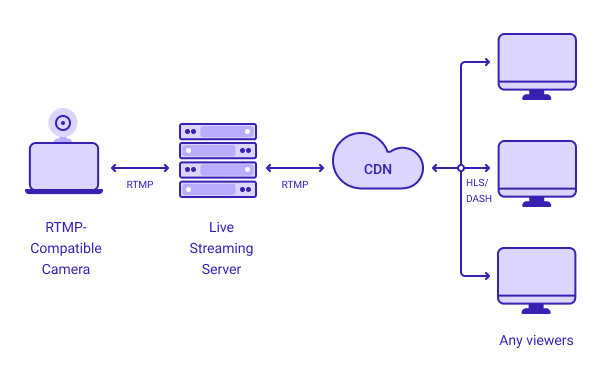By Chris Black, Customer Support RTMP-SERVER, May 25, 2019
RTMP is ideal if you require low latency, though in recent years it has become outdated and as it is based on Flash, it may lack support within some browsers and devices.
Despite these disadvantages, it is ideal to use RTMP as a transport stream. It can be transcoded into other formats such as HLS, which can be distributed more easily.
HLS, originally developed by Apple is a very scalable and flexible protocol compared to RTMP. It is supported by a wide range of devices and browsers and it is fully compatible with our CDN, which can distribute it worldwide at a good latency.
HLS is supported on desktop browsers, smart TVs, and both Android and iOS mobile devices. HTML5 video players also natively support HLS, in comparison with HDS and RTMP. HLS is the safest protocol today for scaling live streaming to a larger audience.

As for the features, the HLS standard also supports adaptive bitrate streaming. The one major drawback is the latency. The latency can be relatively high. But, there are methods for reducing HLS latency.
RTMP used to be the de facto standard for live streaming. Many CDNs offer delivery that scales to the masses. RTMP, however, does not take into consideration that broadcasters and viewers might have internet connections that aren’t always up to the task of transferring the stream at full speed. Smartphones and web browsers are also unable to playback RTMP natively; Browsers used to depend on a flash plugin for playback, which has been phased out over the last couple of years.
RTMP Pros:
1. The actual installation process of a Flash Media Server is simple, effective, and appears to be trustworthy since the protocol was established 10 years ago.
2. RTMP has an exceptional feature where it provides low latency while transmitting live broadcasts.
3. The protocol has the potential to transmit audio and video in any format and rendition.
4. It is also supported universally due to its effectiveness in implementing live streaming.
RTMP Cons:
1. It does not have native support in iOS.
2. RTMP does not work in HTML5, it differs from the HTTP Protocol.
3. The security of delivering video is minimal.
HTTP Pros:
1. HLS is a pocket-friendly protocol that is compatible with all platforms and supports an HTML5 video player.
2. Helps to stream to reach more viewers and also the safest protocol to scale up the content to a massive base audience.
3. The biggest advantage of HLS is that it has the potential to deliver adaptive bitrate streaming where the quality of the content can be expected at a high pixel rate.
HTTP Cons:
1. HLS has latency which is relatively high when compared to RTMP.
2. The performance of HLS on other platforms is minimal when compared to the performance on iOS only.
Depending upon the device support, security features, playback capability, and more, you can choose between these two.
Real-Time Messaging Protocol (RTMP) is a standard originally developed by Macromedia in the mid-200s. Designed for streaming audio and video in the mid-2000s, this protocol is frequently referred to simply as Flash. Macromedia later merged with Adobe, which now develops RTMP as a semi-open standard.
For much of the past decade, RTMP was the default video streaming method on the internet. Only with the recent rise of HLS have we seen a decline in the usage of RTMP. Even today, most streaming video hosting services work with RTMP ingestion. In other words, you deliver your stream to your online video platform in RTMP stream format. From there, your OVP usually delivers your stream to your viewers via HLS.
When to use HLS streaming?
We recommend adopting the HLS streaming protocol all of the time. It is the most up-to-date and widely used protocol for media streaming. It does have one disadvantage, which we mentioned above–HLS has a relatively higher latency than some other protocols. This means that HLS streams are not quite as “live.” In fact, with HLS, viewers can experience delays of up to 30 seconds (or more, in some cases). However, for most broadcasters, this isn’t a problem. The vast majority of live streams can handle a delay like that without causing any sort of user dissatisfaction.
HLS streaming
Streaming to mobile devices
HLS is mandatory for streaming to mobile devices and tablets. Given that mobile devices now make up the majority of internet traffic (around 75% of traffic in 2017), HLS is essential for these users as well.
Using an HTML5 video player
We’ve written extensively about the transition from Flash-based video (usually delivered via RTMP) to HTML5 video (usually delivered using HLS). Check out this blog for more on that subject, including why it’s important to use an HTML5 video player.
HLS streaming
If you’re streaming over the RTMP Server, don’t worry! You’re already using a fully compatible HTML5 video player. Content delivered via the RTMP Server defaults to HTML5 delivery. However, it will use Flash as a backup method if HTML5 is not supported on a given device or browser. This means that even older devices will have no problem playing your content over your RTMP Server account.

